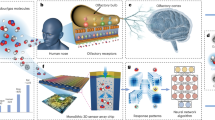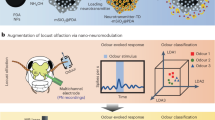Abstract
Biological olfaction outperforms chemical instrumentation in specificity, response time, detection limit, coding capacity, time stability, robustness, size, power consumption, and portability. This biological function provides outstanding performance due, in a large extent, to the unique architecture of the olfactory pathway, which combines a high degree of redundancy and efficient combinatorial coding, with unmatched chemical information processing mechanisms. The last decade has seen important advances in the understanding of the computational primitives underlying the functioning of the olfactory system. The EU-funded Project NEUROCHEM (Bio-ICT-FET- 216916) developed novel computing paradigms and biologically motivated artefacts for chemical sensing, taking its inspiration from the biological olfactory pathway. To demonstrate this approach, a biomimetic demonstrator has been built that features a very large-scale sensor array (65,536 elements) using conducting polymer technology which mimics the olfactory receptor neuron layer. It implements derived computational neuroscience algorithms in an embedded system that interfaces the chemical sensors and processes their signals in real-time. This embedded system integrates abstracted computational models of the main anatomic building blocks in the olfactory pathway: the olfactory bulb, and olfactory cortex in vertebrates (respectively, antennal lobe and mushroom bodies in the insect). For implementation in the embedded processor, an abstraction phase has been carried out in which their processing capabilities are captured by algorithmic solutions implemented in software. Finally, the algorithmic models are tested in mixed chemical plumes with an odour robot having navigation capabilities.















Similar content being viewed by others
References
Abbott LF, Kepler TB (1990). Model neurons: from Hodgkin–Huxley to hopfield. In: Statistical mechanics of neural networks, pp 5–18. Springer, Berlin
Beccherelli R, Zampetti E, Pantalei S, Bernabei M, Persaud KC (2010) Design of a very large chemical sensor system for mimicking biological olfaction. Sens Actuators B 146:446–452
Bernabei M, Persaud KC, Pantalei S, Zampetti E, Beccherelli R (2012) Large-scale chemical sensor array testing biological olfaction concepts. IEEE Sens J 12:3174–3184
Bernardet U, Verschure PFMJ (2010) iqr: A tool for the construction of multi-level simulations of brain and behaviour. Neuroinformatics 8(2):113–134
Buck L, Axel R (1991) A novel multigene family may encode odorant receptors: a molecular basis for odour recognition. Cell 65(1):175–187
Buffo RA, Cardelli-Freire C (2004) Coffee flavour: an overview. Flavour Fragr J 19(2):99–104
Fernandez L, Gutierrez-Galvez A, Marco S (2010) Gas sensor array system inspired on the sensory diversity and redundancy of the olfactory epithelium. Procedia Eng 5:25–28
Ferworn A, Sadeghian A, Barnum K, Rahnama H, Pham H, Erickson C, Ostrom D, Dell’ Agnese L (2006) Urban search and rescue with canine augmentation technology. In: Proceedings of the 2006 IEEE/SMC international conference on system of systems engineering, pp 334–338
Furton KG, Myers LJ (2001) The scientific foundation and efficacy of the use of canines as chemical detectors for explosives. Talanta 54:487–500
Gardner JW, Bartlett PN (1994) A brief history of electronic noses. Sens Actuators B Chem 18(1):210–211
Geladi P, Kowalski BR (1986) Partial least-squares regression: a tutorial. Anal Chim Acta 185:1–17
Guerrero-Rivera R, Pearce TC (2007) Attractor-based pattern classification in a spiking FPGA implementation of the olfactory bulb. Neural Eng 2007. CNE’07. Conference on 3rd International IEEE/EMBS IEEE
Gutiérrez A, Marco S (eds) (2009) Biologically inspired signal processing for chemical sensing, vol 188. Springer, Berlin
Hallem EA, Carlson JR (2006) Coding of odors by a receptor repertoire. Cell 125(1):143–160
Kaplan B, Benjaminsson S, Lansner A (2011) A large-scale model of the three first stages of the mammalian olfactory system implemented with spiking neurons. BMC Neurosci 12(Suppl 1):185
Lledo PM, Gheusi G, Vincent JD (2005) Information processing in the mammalian olfactory system. Physiol Rev 85(1):281–317
López-Serrano LL, Vouloutsi V, Escudero-Chimeno A, Matthews Z, Verschure PFMJ (2012) Insect-like odour classification and localization on an autonomous robot. Lect Notes Comput Sci 7375:371–372
Marco S, Gutiérrez-Gálvez A (2012) Signal and data processing for machine olfaction and chemical sensing: a review. IEEE Sens J 12:3189–3214
Martinez D, Montejo N (2008) A model of stimulus-specific neural assemblies in the insect antennal lobe. PLoS Comput Biol 4(8):e1000139
Mielle P (1996) ‘Electronic noses’: towards the objective instrumental characterization of food aroma. Trends Food Sci Technol 7(12):432–438
Mori K (1995) Relation of chemical structure to specificity of response in olfactory glomeruli. Curr Opin Neurobiol 5(4):467–474
Moser E, McCulloch M (2010) Canine scent detection of human cancers: a review of methods and accuracy. J Vet Behav Clin Appl Res 5(3):145–152
Padilla M, Fonollosa J, Marco S (2013) Improving the robustness of odour sensing systems by multivariate signal processing. In: Nakamoto T (ed) Human olfactory displays and interfaces: odor sensing and presentation. Information Science Reference. IGI-Global
Rock F, Barsan N, Weimar U (2008) Electronic nose: current status and future trends. Chem Rev 108(2):705
Rospars JP et al (2010) Odour transduction in olfactory receptor neurons. Chin J Physiol 53(6):364–372
Sandström M, Proschinger T, Lansner A (2008) Fuzzy interval representation of olfactory stimulus concentration in an olfactory glomerulus model. BMC Neurosci 9(Suppl 1):123
Sell CS (2006) On the unpredictability of odor. Angewandte Chemie Int Ed 38:6254–6261
Smith D, Španěl P (2007) The challenge of breath analysis for clinical diagnosis and therapeutic monitoring. Analyst 132(5):390–396
Vassar R, Chao SK, Sitcheran R, Nuñez JM, Vosshall LB, Axel R (1994) Topographic organization of sensory projections to the olfactory bulb. Cell 79(6):981–991
Vouloutsi V, Lopez-Serrano LL, Mathews Z, Escuredo Chimeno A, Ziyatdinov A, Perera i Lluna A, Bermúdez i Badia A, Verschure P (2013) Artificial olfaction in robots. In: Persaud KC, Marco S, Gutierrez-Gálvez A (eds) Neuromorphic olfaction. Frontiers in Neuroengineering Series. CRC Press, Boca Raton
Ziyatdinov A, Fernández-Díaz E, Chaudry A, Marco S, Persaud KC, Perera A (2012) A software tool for large-scale synthetic experiments based on polymeric sensor arrays. Sens Actuators B Chem 177:596–604
Acknowledgments
This work was funded from the European Community’s Seventh Framework Programme. (FP7/2007–2013) under grant agreement No. 216916: Biologically inspired computation for chemical sensing (NEUROCHEM). The authors would like to acknowledge the contribution of all the researchers and technicians participating in the NEUROCHEM project.
Author information
Authors and Affiliations
Corresponding author
Rights and permissions
About this article
Cite this article
Marco, S., Gutiérrez-Gálvez, A., Lansner, A. et al. A biomimetic approach to machine olfaction, featuring a very large-scale chemical sensor array and embedded neuro-bio-inspired computation. Microsyst Technol 20, 729–742 (2014). https://doi.org/10.1007/s00542-013-2020-8
Received:
Accepted:
Published:
Issue Date:
DOI: https://doi.org/10.1007/s00542-013-2020-8




